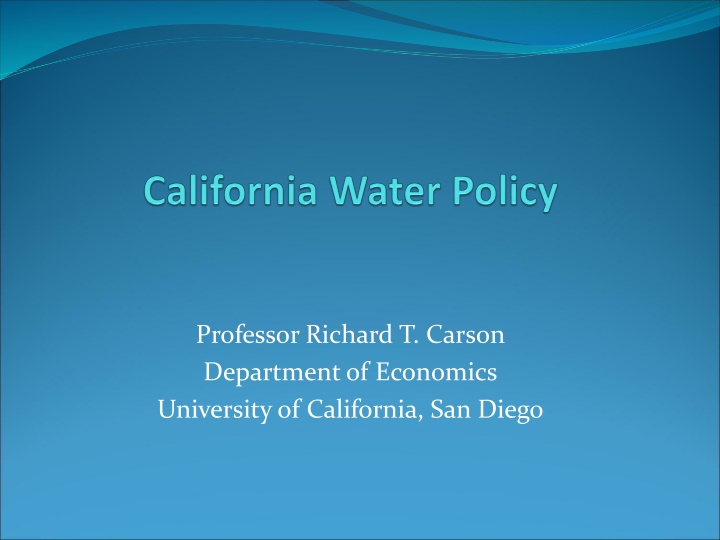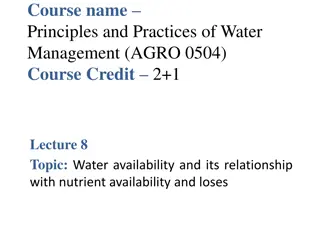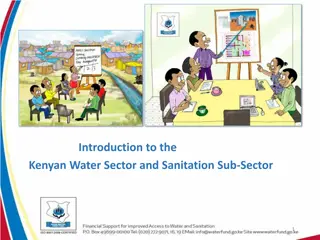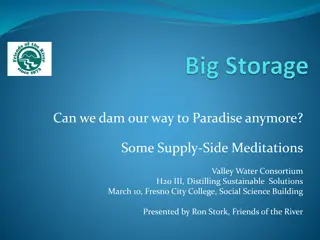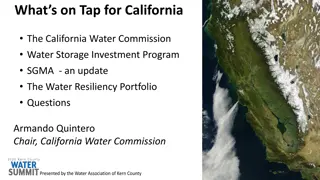California Water History: Conflict and Evolution of Policy
Discover the rich history of water conflicts in California, from North versus South divides to the role of agriculture, urban areas, and environmentalists. Explore the long-standing struggles for water resources, influenced by past Spanish settlements and historical water customs. Delve into the complexities of water allocation and the ongoing policy issues faced by the state.
Download Presentation

Please find below an Image/Link to download the presentation.
The content on the website is provided AS IS for your information and personal use only. It may not be sold, licensed, or shared on other websites without obtaining consent from the author.If you encounter any issues during the download, it is possible that the publisher has removed the file from their server.
You are allowed to download the files provided on this website for personal or commercial use, subject to the condition that they are used lawfully. All files are the property of their respective owners.
The content on the website is provided AS IS for your information and personal use only. It may not be sold, licensed, or shared on other websites without obtaining consent from the author.
E N D
Presentation Transcript
Professor Richard T. Carson Department of Economics University of California, San Diego
California and Water History Evolution of policy issues
Long Standing California Water Conflicts North versus South 80% comes from North of Sacramento 80% used South of Sacramento East versus West Most water originates on eastern mountains and used in west on coast or Central Valley Agriculture versus Urban Cost allocation and water shares Environmentalists versus Agriculture & Urban Large role of political system and courts
History The Long View Good Sources: Norris Hundley (2001) The Great Thirst: Californians and Water History (University of California Press) Marc Reisner (1986) Cadillac Desert (Penguin) California experienced mirrored in other western U.S. states Indian (Pre-Spanish) California support sizeable population (300,000) Most of the population lived in the interior along the large rivers. Largely existed on fishing (salmon, steelhead) & hunting Irrigation developed in Owens Valley & along Colorado River Little influence on current water situation
Spanish Settle along the coast where settlements could be supplied by ship Used a combination of religion (missions) and military Initial settlements on good harbors & fresh water supply San Diego (1769), Monterrey (1770), San Francisco (1777), Santa Barbara (1782) Other missions and settlements (pueblos) fill in: San Jose (1777), Los Angeles (1781) Spanish Crown asserts total control of water Land/water though said to be held in trust for Indians
Spain and California similar Arid Water supply variable Spanish water customs/law applied to both Crown grants settlements temporary water rights Many settlements have substantial problems/failure Water shortages Agricultural production issues Custom is proportionate sharing of water Including shared responsibility to maintain system Issues arise in sharing water/other provisions across missions and pueblos Formal procedures for designated Royal official to adjudicate water (and related land boundary) conflicts Often slow
Water problems expand Settlements along coast grow taxing water supplies at some times of the year Spanish Crown desires settlements in interior Conflicts with damming upstream water supplies Develops into a system of senior do no harm rights Spanish Crown wants to give out large land (rancho) parcels Water on land usable for livestock & domestic purposes Could petition to irrigate limited (10%) amount of land Property rights could be obtained if water used for some purpose, typically irrigation, for 10 years and no complaints lodged with authorities This custom influences later western U.S. water law
Spanish water law impacts western United States via Custom 1848 Treaty of Guadalupe Hidalgo ending war with Mexico Most important case was Los Angeles assertion of pueblo water rights claiming water from the Los Angeles river California s Indian population had declined by 50% (to 150,000) during Spanish/Mexican rule. Declined to 20,000 by 1900 under American rule. California non-Indian population booms from 10,000 in 1846 to 100,000 in 1849 to 1.5 million in 1900.
Huge population jump soon after U.S. takes control of California due to discovery of gold in 1848. Need for water for gold mining drives practice on ground: Gold largely on public land Often not on a river but within a few miles Preemption Act of 1841 recognized rights of first settlers to buy government land later at lowest price Strong informal custom of first settlers to support each other over new entrants Claims to use water only good as if mining still being undertaken Claims enforced by informal miner s courts Federal/California government did not step in
First in time/first in right custom/implicit right develops Recognized in law in California in 1851 as prior appropriation and by Federal government (who owned much of the land) in 1866 Clear conflict with riparian water rights recognized by California in 1850 and long the basis of most Federal and state water law Appropriative water rights recognized now in all western U.S. states Similar to Spanish water law in emphasis on use but under Spanish water law initiative for assign water rights lay with Crown. In U.S. emphasis on actions of individuals. Initially only miners could take water but California court in 1855 upholds appropriative right to take water to sell to miners: Creates a water industry. Practice of hydraulic mining using water pressure to move dirt and rocks to expose gold develops Immensely profitable and environmentally destructive Shut down in 1884 by U.S. 9thCircuit Appeals Court decision on the basis of damaging property of others and impairing navigation One of the earliest major environmental decisions by a U.S. court
Riparian and prior appropriation water law eventually clash as a few people amass huge quantities of land in Central Valley Small number of people had filed for appropriative rights on rivers substantially exceeding total river flow Small number of people controlled much of riparian rights In 1886 California Supreme Court (Luxv. Haggin) that: Riparian rights inherit in all private lands, including public lands when they passed into private ownership Appropriator possessed superior rights to riparian if appropriator began taking water before riparian acquired property Less a victory for riparian rights than it might seem because riparian could not extract and store water. Key problem: Too much water at the wrong time and too little water at the right time
Small farmers/land owners react against water grab by big land owners. Want to set up irrigation districts. California pass the Wright Act 1887 Allowed for public irrigation districts Locally controlled Could take water under fairly loose conditions Could tax land owners for district costs Encouraged a large increase in irrigated agriculture Subject of lots of litigation with big land owners Borrowed (and often defaulted) large sums of money
Other developments of the late 1800s Flood control projects Ad hoc community and farming groups Flood control districts similar to irrigation districts Mutual water companies Non-profit set up so each household or acre owned one share Part of the process of setting up Anaheim, Pasadena and other villages/cities in Southern California For profit water companies Cities like LA and San Francisco turned to private operators as initial water supplies proved inadequate Very high (monopoly rates) and poor service soured public on moving in this direction Los Angles wins major 1895 legal case on pueblo water rights taking control of all water from Los Angeles River
Federal Government Gets Involved 1878 John Wesley Powell (of the U.S. Geological Survey) produced the Report on the Lands of the Arid Region of the United States : There is insufficient water to irrigate all of the land which could be irrigated. Fed passes Desert Land Act (1877) and Casey Act (1894) intended to encourage small farms and irrigation but have tend to only increase power of western Land Barons through dummy purchases Depression/Panic of 1893 sweeps out laissez-faire policies and in favor of a progressive reform agenda Emphasis on technological solutions to social problems
Reclamation Act of 1902 Authorized Secretary of Interior to conduct Field surveys Build storage works Divert water Withdraw land for irrigation Government offers 40 to 160 acre tracts to public Land open to settlers from any state No right to water for farms over 160 acres Existing land holders only eligible up to 160 acres Congress funds in 1906 Electricity from dams provides additional funding source
Large scale water shortages in early 1900s in major California cities Rainmakers such as Charles Hatfield (SD, LA) California coastal cities regain control over contracts to private water companies Cities start to search for larger more secure water supply Water availability becomes the key to population growth State of California inventories water resources and imposes some control over irrigation/water districts
San Francisco Always had a difficult water situation. Spanish picked location for harbor knowing there were few springs. Water imported from Marin County in barrels Rapid population growth results in city providing franchise to Spring Valley Water Works (SVWW) Frequent fires brought home need for more water Franchise granted in exchange for SVWW providing water to fight fires SF lacked money for building/operating water works SVWW unpopular for high prices/bad service SF obtains mandate from state legislature that water company should be owned by the city
SF could take over SVWW by condemnation But had to pay fair market value Needed cheap source of water to reduce price Filed for Tuolumne River water rights (1901) which drained part of Sierra Nevada mountains including Hetch HetchyValley Three problems: Hetch Hetchy was part of the newly created Yosemite National Park SVWW fought plan as unneeded Political rivals who took control of SF took bribes to go after water from American and Consumnes River Three events intervene: SF earthquake of 1906, head of Union Labor party kicked out for corruption, James Garfield becomes Secretary of Interior
Hetch Hetchy SVWC continued to oppose as did San Joaquin Valley farming interest who claimed prior water rights. Wilderness advocates lead by John Muir who had help make Yosemite a national park in 1890 strongly opposed Muir believed Hetch Hetchy more beautiful than Yosemite Sierra Club setup in 1892 initially led fight Lead to a split in Sierra Club/conservation movement Preservationists versus careful management for future Muir creates Society for Preservation of National Parks Reclamation Service argues other sources for SF water SF city engineer discovers Reclamation Services and preservations relied on information from SVWC
Interior orders an assessment. Relies on SF submission Perception by outgoing Taft/incoming Wilson Administrations that Congress should approve project Congress holds hearings on Raker Act on Hetch Hetchy Show piece of preservationist s testimony on developing the Mokelumne River is a disaster as main witness recants Raker Act passes giving prior rights to irrigation districts, SF Hetch Hetchy, forbids sale of water/power to private entities Power provision never enforced/power sold to PG&E After passing various SF bond issues and large cost over runs, water starts to flow in 1934. SVWW purchased 1930 Donald Hodel, Reagan s Secretary of Interior, proposes in 1987 removing the O Shaughnessy Dam and turn Hetch Hetchy into a new national park
East Bay: Oakland/Berkeley Decides not to be dependent on SF for water Goes after Mokelumne River Excess SF water sold to mainly to South Bay cities Less water/power but took only six years to build (1929)
Los Angeles Population was growing rapidly 1890 to 1900, grows from 50,000 to 100,000 1900-1904, 100,000 to almost 200,000 Regains control of water lease to private Los Angeles Water company in 1898. Buys companies facilities 1902. Los Angeles v. Pomeroy court case in 1899 reaffirms pueblo water rights to areas annexed by LA LA city charter amended in 1903: 2/3 vote required to give up any water rights Establishes 5 member Board of Water Commissioners
William Mulholland Rose in 8 years from day laborer to superintendent of the water system for Los Angeles Water Company Retained in position by LA Board of Water Commissioners Only person who knew how whole water system operated Immediately added water meters to provide incentives to reduce water wastage and updated system System becomes profitable and reliable With former LA mayor, Fred Eaton, turns attention toward securing LA s future by obtaining enough water to support an order of magnitude population increase
Owens River Valley Located 235 miles from LA on eastern side of Sierras Major advantage is possibility of gravity fed aqueduct Fred Eaton buys up substantial amounts of land and water rights in the Owens Valley. Plan kept secret Controversy over Eaton s role resolved by selling to LA at cost Eaton makes large profit on leasing a reservoir site Needs to get Reclamation Service consent Joseph Lippincott (southwestern U.S. supervising engineer) Hot weather/drought results in overwhelming public support for bond issue to fund entire project President Theodore Roosevelt/Congress approve 1906
Los Angeles Aqueduct takes five years to build. Project completed on time and within budget. Striking contrast to San Francisco LA uses the availability of water to justify annexing large amounts of land for growing city. Value of land in San Fernando Valley goes up dramatically Charges of trading on insider knowledge
Initially LA Aqueduct beneficial to Owens Valley Changed in 1920 s with increased water diversions/drought Aqueduct dynamited several times Plight of residents attracts national press attention LA buys up most remaining land in Inyo county Recreation (from LA) develops in area and to reduce tax bill LA sells off land without water rights St. Francis Dam north of LA collapses after being filled Originally blamed on Owens Valley activists Mulholland takes blame and resigns in 1928 Leaves LA Department of Water and Power most powerful municipal agency in U.S. Population of LA surpasses SF
Mono Lake With population still growing and a new drought LA acquires water from adjacent Mono County from streams feeding Mono Lake in 1930 Passes new bond issue and extends LA Aqueduct
Boulder Dam, Colorado River & MWD Reclamation Service (now Bureau of) wants to do grand projects like LA and SF Starts bigger projects (Salt River project in Phoenix) and large concrete dams in Idaho, N.M. &Wyoming Arthur Powell Davis identifies Colorado River and a huge dam on it as key to harnessing the waters of the West Needed an interest group to promote and found it in the farmers Imperial Valley of Southern California 600,000 very fertile acres with water Difficult water situation with Alamo Canal through Mexico 1905 huge surge of water break through creating Salton Sea More Colorado River water started going irrigate farm land in Mexico owned by large wealth landholders from Los Angeles
Imperial Irrigation District Set up 1911 Congressional bill to build All American Canal introduced 1919 Bureau of Reclamation wants to fend off Army Corp of Engineers building All American Canal More serious Congressional bill introduced in House and Senate in 1922 by Senator Hiram Johnson, former California Governor Huge dam on Colorado seen necessary to control water surges and to generate electricity to pay for building canal
Sets off alarm bells in other states along Colorado Supreme Court ruling in Wyoming v. Colorado applies principle of prior appropriation to sharing Colorado s water between states Building Boulder Dam on Colorado would allow California to dramatically increase its share Six of seven states along Colorado River (all but Arizona) come to agreement on allocating water putting the 1922 Colorado River Compact into effect California guaranteed 4.4 million acre feet California gets Boulder Dam and All American Canal
New competitor for Californias share of Colorado River Metropolitan Water District of Southern California created Consortium of 26 cities and water districts in Ventura, Los Angeles, San Bernardino, Riverside, Orange and San Diego Counties Los Angeles effectively controls initially and pays most of the cost through property taxes Does not take most of the water due to other sources San Diego the largest purchaser of MWD water 1952 Laguna Declaration of MWD promising water always availabile fuels Southern California population growth
Imperial Valley poses substantial problems to Bureau of Reclamation Powerful opposition to 160 acre limitation wins out Most remaining small farmers bought out Absentee landlords in LA, SF with managers/immigrant farm labor Water provided at very subsidized rates Huge profits with dependable water and Colorado flooding tamed Boulder Dam power split between Los Angeles Department of Water and Power and Southern California Edison
Central Valley Project (CVP) Central Valley is 450 miles long and between 40 to 75 miles long (from Redding to Bakersfield) Water from western Sierra Nevada mountains Light precipitation which comes after growing season Frequent floods Top part (Sacramento River) had too much water Bottom (San Joaquin [River] Valley) usually had too little Bureau of Reclamation projects small often unsuccessful Number of small farms increases but Three California bond issues in 1920 s fail to fund project
State of California scales back project to essential elements: Major reservoir on Sacramento River Improve navigability along lower Sacramento River Prevent salt water intrusion in Sacramento Delta Provide fresh water for cites along Sacramento Release water at right times into drier San Joaquin Valley Build an aqueduct to Southern California Southern California backs out having gotten Colorado River water Riparian water right holders win 1926 state supreme court ruling saying could use water even if wasteful. Major threat to project. California voters amend constitution in 1928 prohibiting: Wasting water or unreasonable use
California continues to try to get project off ground Desires more and more Federal support Concedes that power generated will be public Finally approve bond issue for CVP Barely survives ballot attempt to overturn LA votes 2 to 1 against CVP (taxation with no benefits) California unable to sell bonds Roosevelt agrees to have Feds take over CVP project Bureau of Reclamation gains control Roosevelt insists reclamation (160 acres/power) rules be followed Work begins 1937 First power generated for sale 1944 Water to San Joaquin Valley in 1951
160 Acre Fight With low-cost water big farms highly profitable In San Joaquin Valley alternative was groundwater pumping Roosevelt supporters saw 160 acre limitation key to protecting/encouraging family farms Study by Walter Goldschmidt (UC) for Bureau of Agricultural Economics show dramatic difference in income distribution, community structure quality of life for communities composed of small versus large farms Truman/Eisenhower much more big business friendly Allow technical compliance with 160 Acre limitation Sales of power to private companies used to subsidize project costs
State Water Project (SWP) Three major problems with seen with CVP Fear Feds would enforce 160 acre limit Western side of San Joaquin Valley lacked access Heavy use of groundwater Most of the land controlled by powerful interests Did not do much for urban areas 1980 population (20M) predicted to be double 1950 population California first seriously proposes SWP in 1951 Response in part to Bureau of Reclamation plans to exchange water between western states Oregon water south, Owens Valley water east
Key Elements of SWP Build world s tallest dam at Oroville on Feather River Sacramento tributary, heaviest flowing undammed River Deliver water to Sacramento Delta/San Francisco Area Reduce seawater intrusion Dilute pollution Serve new urban growth Build aqueduct to take water to western San Joaquin Extend aqueduct to Southern California urban areas Had to go over Tehachapis mountains
Funding the SWP Appropriation for planning studies in 1951 Massive flood in 1956 sparks institutional change 100,000 squares miles, $200M property loss, 64 lives Seen as preventable if Oroville Dam had been built California Department of Water Resources created Incorporated 64 separate independent state agencies 1959 Burns-Porter Act 1.75 M in bonds (roughly size of annual state budget) 2.50 M in future revenue from off-shore oil Pushed through legislature by Governor Pat Brown North v. South, Agriculture v. MWD, LA v. other MWD County-of-origin legislation waived for length of bonds State ballot measure passes by 0.3% percent of the vote
Building the SWP Water reaches Alameda county (Bay area) in 1962 Water reaches San Joaquin in 1968 Crosses Tehachapis moutains in 1971 West branch aqueduct brings water to Castaic Lake Reaches Lake Perris (Riverside County) in 1973
SWP Evolves Project largely pays for itself Tideland oil revenue goes up as OPEC raises oil prices All electricity from SWP plus 2x more goes to pump water Agricultural interests get cheaper and cheaper water Pat Brown originally imposed $2 per acre foot water surcharge on large farms rescinded by Reagan MWD agrees to unfavorable capacity definition Much water declared surplus Farmers pay $13 per acre foot rather than expected $43 Agriculture greatly expands Availability of water fuels residential growth LA, Orange, Riverside San Diego, San Bernardino counties
California v. Arizona Conflict between Arizona & California over Colorado Arizona did not sign original Colorado River Compact Central Arizona rivers developed in 1940/1950 s Arizona proposes Central Arizona project in 1947 Treaty with Mexico gave Mexico 1.5M acre feet Split equal between upper & lower Colorado River States Court battle between Arizona & California over water Filed in 1952, Supreme Court decision 1963 Effect of court decision heavily against California Based on faulty interpretation of Congressional intent Effectively takes away surplus water from California MWD as junior partner on Colorado big loser MWD responds by contracting for more water from SWP
New Conflicts With Environmentalists In 1956, Sierra Club and other environmental groups block Echo Park Dam near Colorado/Utah border But give in on Glenn Canyon Dam on Colorado Environmental groups defeat plans for two dams near Grand Canyon. Slows Central Arizona Project Congress guarantees California 4.4 MAF of Colorado Federal Wild and Scenic River Act passes in 1968 Makes it harder to dam new rivers California passes similar legislation in 1972
Peripheral Canal Second phase of SWP Eliminated from original plan to cut cost 43 mile long, 400 foot wide, 30 feet deep unlined ditch Start on Sacramento River, 15 miles below capital Brings water across Sacramento Delta Needed to maintain water quality Reduce seawater intrusion and environmental harm Increase quantity of water available to ship south Saved 2.25 million acre feet that would flow to ocean Needed to fulfill commitments to SWP contractors Interest driven by loss of Arizona v. California case
Five major problems High cost San Joaquin farms preferred groundwater (overdrafting) to paying for most of the cost of the project MWD reluctant to pick up entire cost Northern California get no direct benefits and shipping water south competes with their perceived future needs Environmental groups opposed Use of more water did not offset clear benefits to SF Bay-Delta More subsidies to large farmers seen as indefensible
Peripheral canal becomes political hot potato Passed from Reagan to Jerry Brown Brown cannot make up his mind Northern California/environmentalists strongly oppose Strong agricultural support/moderate S. Cal. support Decides to push forward but first ask voters to pass Proposition 8 protecting Delta/Northern California rivers from additional water exports Agriculture opposes but MWD sees as necessary compromise Proposition 8 passes 54 to 46% Vote in Northern California strongly favors, Central Valley opposed, and Southern California almost perfectly split Key provision of Prop 8 was that it only went into effect if Peripheral Canal gained approval
Peripheral Canal opponents assemble a strange coalition Environmental groups opposing any increase in SWP water Agricultural groups opposed to Prop 8/want better deal Signatures collected for a referendum on Peripheral Canal Most costly political campaign in California at time Opponents used all of the standard arguments plus rapidly rising cost estimates (2.5 billion to 23 billion) for project California to pick up 96% of cost [earlier Fed to pay 75%] Opponents successful in conveying that Southern Californians not agriculture would pay the lion s share Peripheral Canal overturned by vote of 63% to 37% in 1982 Over 90% of Northern California against Cost and environmental concerns two major reasons to oppose First rejection of a major water project since 1920 s
